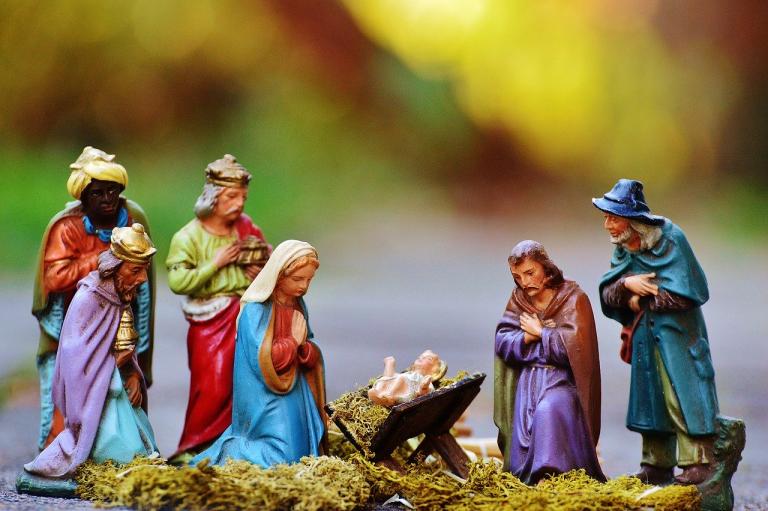A fixture of Christmas decor is the nativity scene, the depictions of Mary, Joseph, and the Baby Jesus, plus shepherds, Wise Men, and a small menagerie of animals. These can be live portrayals with actual human beings and animals, or elaborate statues, or two-dimensional cut-outs, or little figurines. Have you ever wondered where nativity scenes and the customs of displaying them come from?
An article by Georgetown history professor Vanessa Corcoran entitled How St. Francis created the Nativity scene, with a miraculous event in 1223 tells the tale.
She says that nativity scenes were the invention of St. Francis of Assisi. In 1223, she says, the populist friar petitioned Pope Honorious III to allow him to do something “for the kindling of devotion” to the birth of Christ. He set up a manger, put hay in it, got a live ox and an ass, and then put a doll in the manger to represent the Christ child.
Another article on the subject by Gretchen Filz, entitled The Story of St. Francis of Assisi and the First Nativity Scene, as told by St. Bonaventure, quotes him telling a friend, “I want to do something that will recall the memory of that Child who was born in Bethlehem, to see with bodily eyes the inconveniences of his infancy, how he lay in the manger, and how the ox and ass stood by.” The article adds that Francis set up the scene in a cave, where he held a special worship service.
Prof. Corcoran says that our information comes from St. Bonaventure’s Life of St. Francis of Assisi, so let’s go to that source for the details, as quoted by Gretchen Filz:
It happened in the third year before his death, that in order to excite the inhabitants of Grecio to commemorate the nativity of the Infant Jesus with great devotion, [St. Francis] determined to keep it with all possible solemnity; and lest he should be accused of lightness or novelty, he asked and obtained the permission of the sovereign Pontiff. Then he prepared a manger, and brought hay, and an ox and an ass to the place appointed.
The brethren were summoned, the people ran together, the forest resounded with their voices, and that venerable night was made glorious by many and brilliant lights and sonorous psalms of praise.”. . .
The man of God [St. Francis] stood before the manger, full of devotion and piety, bathed in tears and radiant with joy; the Holy Gospel was chanted by Francis, the Levite of Christ. Then he preached to the people around the nativity of the poor King; and being unable to utter His name for the tenderness of His love, He called Him the Babe of Bethlehem.”
The sensational impact of this Christian work of art was magnified by the popular piety of the time. Observers claimed they heard the Christ doll crying! (This was before the “Away in the Manger” version of the nativity scene, with its “no crying He makes.”) The hay was said to heal animals.
Before too long, every church in Italy would put up nativity scenes. At first, these were “live” presentations, but then artificial statues were used, which grew more and more elaborate, with richly robed figures, which now included shepherds and Wise Men. Many different styles and materials were used, often reflecting particular regions and cultures. And they began to be used not just in church but, in the form of small figurines, in homes. (See this.) The original by St. Francis was an interesting combination of live and artificial, with a baby effigy and live animals.
To be sure, the Nativity of Christ, with Mary and Joseph and animals, were staples of Christian iconography, going back to the grave art of the early church and continuing with two-dimensional icons in the Orthodox Church. And this became an enormously popular subject in Renaissance art.
I suspect that another imaginative influence were the Mystery Plays, which re-enacted Bible stories on wagons known as “pageants,” and which usually included a “Christmas pageant.” A wonderful surviving example is the Second Shepherd’s Play, which combines uproarious comedy with a moving presentation of the Gospel, featuring the substitutionary exchange between a rascally shepherd and “the Lamb of God, who takes away the sin of the world” (John 1:29). (It’s a fun custom to read this play every Christmas. Or to do group readings at Christmas parties. Here is a modern translation. Here is the original middle English.)
Nativity Scenes began as objects of Roman Catholic devotion, but by the 19th century, Protestants had (mostly) accepted them too. At one time, Catholics had Nativity scenes, while Protestants had Christmas trees. (Probably because it was thought, rightly or wrongly, that Luther introduced them. But read this Lutheran defense of Nativity Scenes–a.k.a. “creches”–as well as crucifixes.)
Now the figures of Mary, Joseph, the Baby, and company are erected in town squares, Santa and reindeers and symbols of other religions are included, and atheists file law suits against them. In that, the atheists would be in agreement with the Puritans, who also opposed them altogether, considering them to be idols, though I’m not sure what false god they cause people to worship.
Nativity scenes began with St. Francis, but they would not have spread unless they struck a chord–a Christmas chord–with ordinary Christians. Christmas is about the Incarnation, that God is no longer merely spiritual, much less an intellectual abstraction. Rather, the Second Person of the Trinity “was made flesh and dwelt among us” (John 1:14). That is, He became physical, tangible, material.
Seeing a Nativity Scene, with its hay and animals, its ordinary shepherds and regal magi, reminds us of the tangibility and historicity of Jesus Christ, who came for each of us.
Image by Alexas_Fotos from Pixabay














